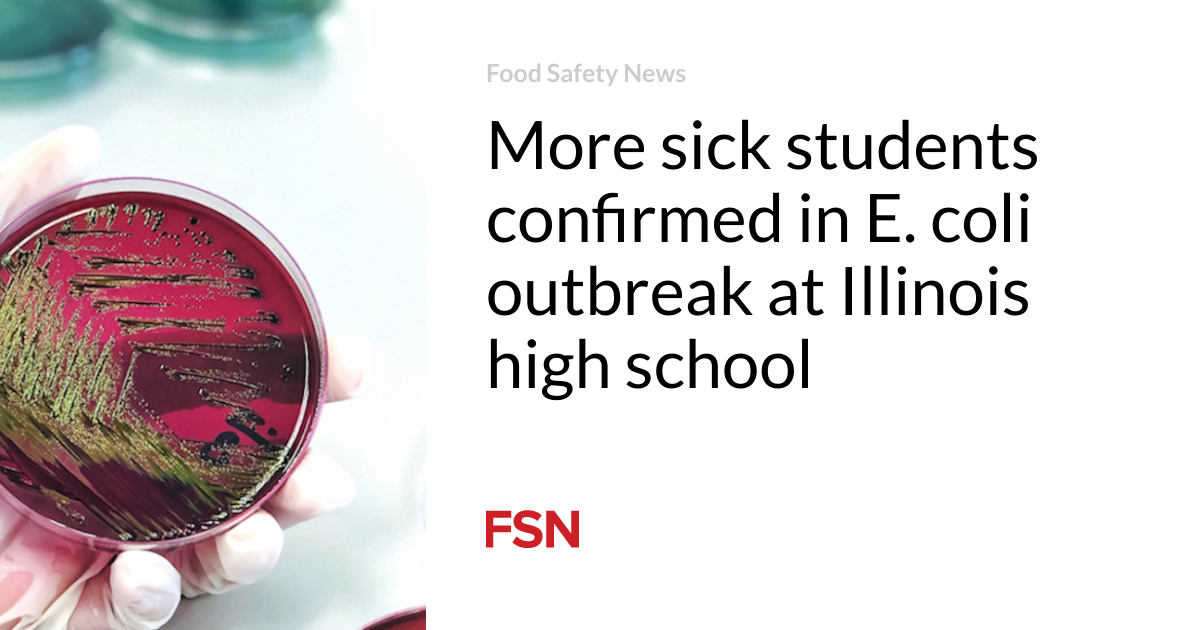Infection
More sick students confirmed in E. coli outbreak at Illinois high school
Public health officials are slowly identifying more students with E. Coli infections in an outbreak associated with Huntley High School in Illinois.
The outbreak was identified on Sept. 17 and now includes nine confirmed patients and several suspected patients. The McHenry County Department of Health has not reported whether any of the students are hospitalized.
Investigators are working to discover the source of the pathogen, but have not yet identified a specific food.
The county health department has reported that no other cases of infection are known of outside of the student population of Huntley High School. Public health officials are interviewing ill students to try to determine if there is a common food they ate before becoming sick.
The school remains open, but school district officials are cooperating fully with public health to investigate the outbreak.
Post Outbreak Inspection Reports:
September 18:
Onsite for inspection in regards to a complaint. Water and ice samples were obtained. Refer to RFS #3879 for further notes. Items #1-29 have been marked in compliance to document a complaint report, not all items were evaluated. A signature for a representative of the school could not be obtained due to connectivity problems within the establishment.
September 19:
Onsite in regard to a complaint. Items #1-29 have not all been evaluated and have been marked in compliance. For further notes refer to RFS complaint #3879
Item #16
Section 16 (Pf) Hot water sanitizing rinse at dish machine is less than 180°F. Repair/replace unit so that hot water rinse is maintained between 180°F to 194°F. Reference 4- 501.112.
The automatic dish machine was not registering the appropriate rinse temperature: Correct by 9/29/23 The facility can utilize the auto dish machine for washing and rinsing of equipment, etc., sanitation must take place in the 3-compartment sink.
Item #24
Section 24 (Pf) If time without temperature control is used as the public health control for a working supply of time/temperature control for safety food before cooking, or for ready-to-eat time/temperature control for safety food that is displayed or held for sale or service: Written procedures shall be prepared in advance, maintained in the food establishment and made available to the regulatory authority upon request that specify: Provide a written procedure for the TCS foods that are held out of temperature control. Reference 3-501.19 (A)(1).
The facility has begun to utilize time as a public health control for the hot sub sandwiches and there is not written procedure on hand: Correct by 9/29/23.
Item #24
Section 24 (Pf) If time without temperature control is used as the public health control up to a maximum of 4 hours: The FOOD shall be marked or otherwise identified to indicate the time that is 4 hours past the point in time when the FOOD is removed from temperature control.
All TCS foods that are held under time as a public health control shall have a system of identification to indicate the time of 4 hours past the point of when the TCS foods were removed from temperature control. Reference 3-501.19 (B)(2)
The hot sub sandwiches were not marked with a discard time of 4 hours past the time it was removed from temperature control. Staff indicates that all hot sub sandwiches are purchased prior to the end of lunch service which is within the 4-hour time limit after removal. The facility is to identify the time regardless of whether items will be sold out during the 4-hour time frame or not: Correct by 9/29/23.
September 21:
Section 56 (C) Intake/exhaust air ducts (vents) with accumulation of dust. Intake and exhaust air ducts shall be cleaned and filters changed so they are not a source of contamination by dust, dirt, and other materials. Reference 6-501.14.
Observed the vent covers over the file cabinet area and in the dry storage area soiled with dust. Correct by next routine inspection.
About E. coli infections
Anyone who has a student at Huntley High School who developed symptoms of E. coli infection should seek medical attention and tell their doctor about their possible exposure to the bacteria. Specific tests are required to diagnose the infections, which can mimic other illnesses.
The symptoms of E. coli infections vary for each person but often include severe stomach cramps and diarrhea, which is often bloody. Some patients may also have a fever. Most patients recover within five to seven days. Others can develop severe or life-threatening symptoms and complications, according to the Centers for Disease Control and Prevention.
About 5 to 10 percent of those diagnosed with E. coli infections develop a potentially life-threatening kidney failure complication, known as a hemolytic uremic syndrome (HUS). Symptoms of HUS include fever, abdominal pain, feeling very tired, decreased frequency of urination, small unexplained bruises or bleeding, and pallor.
Many people with HUS recover within a few weeks, but some suffer permanent injuries or death. This condition can occur among people of any age but is most common in children younger than five years old because of their immature immune systems, older adults because of deteriorating immune systems, and people with compromised immune systems such as cancer patients.
People who experience HUS symptoms should immediately seek emergency medical care. People with HUS will likely be hospitalized because the condition can cause other serious and ongoing problems such as hypertension, chronic kidney disease, brain damage, and neurologic problems.
(To sign up for a free subscription to Food Safety News,click here)

